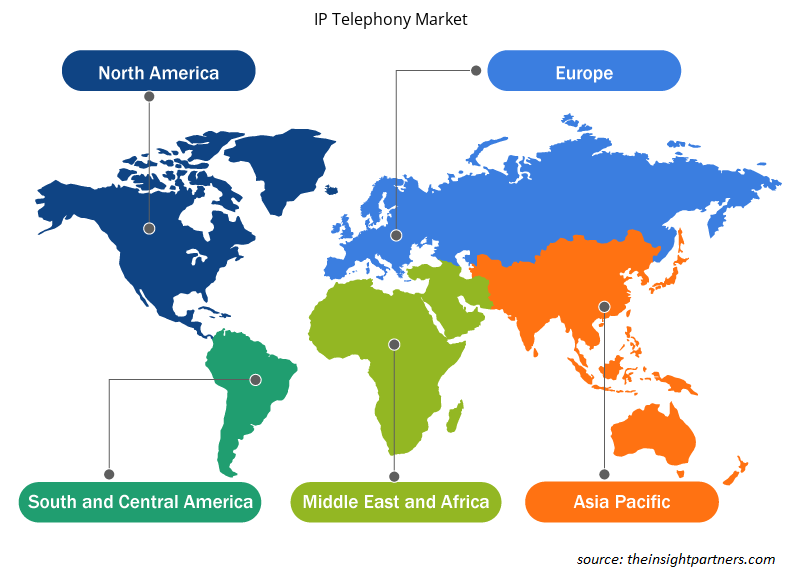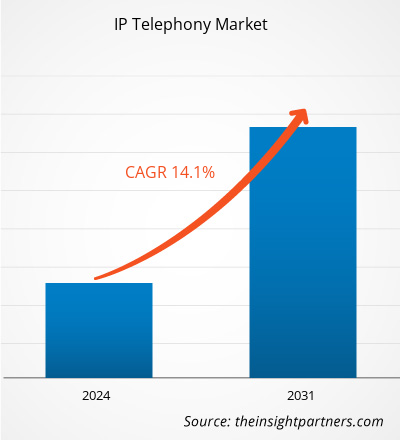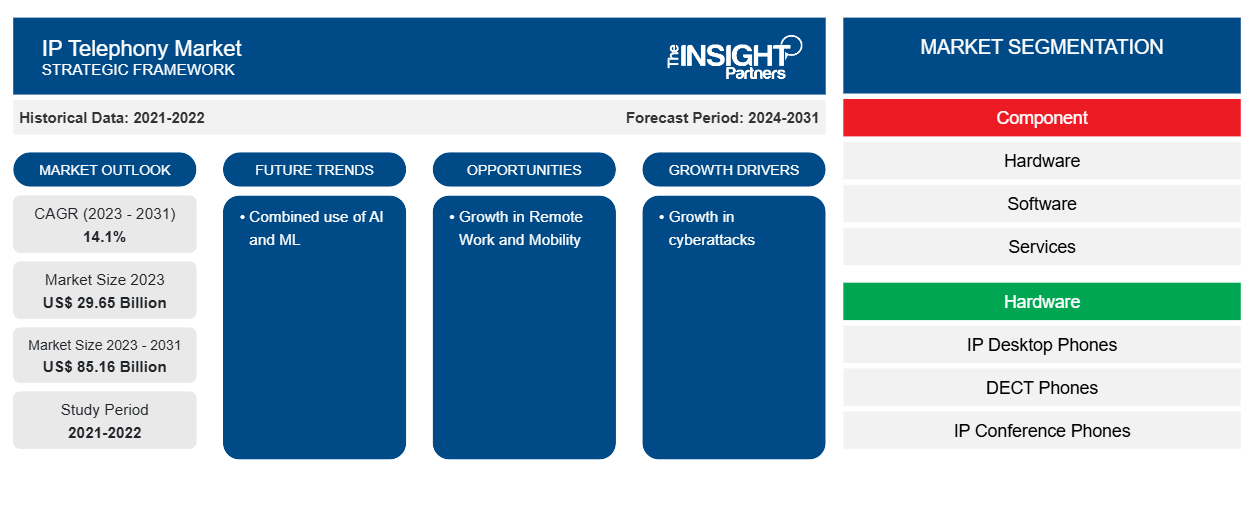Der Markt für IP-Telefonie soll von 29,65 Milliarden US-Dollar im Jahr 2023 auf 85,16 Milliarden US-Dollar im Jahr 2031 anwachsen. Der Markt für IP-Telefonie soll zwischen 2023 und 2031 eine durchschnittliche jährliche Wachstumsrate (CAGR) von 14,1 % verzeichnen. Voice over IP (VoIP) ist ein Dienst und eine Anwendung, die unter den Begriff IP-Telefonie fällt. Dabei handelt es sich um die Übertragung von Sprachkommunikation über IP-Netzwerke.
IP-Telefonie-Marktanalyse
Internet Protocol (IP)-Telefonie bietet eine Vielzahl von Diensten, wie Sprachanrufe, Videoanrufe, Voicemail, Faxen, Instant Messaging (1M) und Videokonferenzen. Im Gegensatz zu VolP bietet IP-Telefonie oft mehr als nur Sprachfunktionen. IP-Telefonie kommt Organisationen jeder Größe zugute, indem sie ein kombiniertes Netzwerk für Telefon- und Internetfunktionen bereitstellt. IP-Telefonie bietet geringere Kosten, eine einfachere Infrastruktur, Skalierbarkeit und Mobilität und ist daher für Endbenutzer attraktiv.
Marktübersicht für IP-Telefonie
IP-Telefonie bezeichnet alle Systeme der internetbasierten Telekommunikation, darunter Fax und andere Technologien. Dabei werden verschiedene Open-Source-Protokolle verwendet, um Daten vom Telefon an den Dienstanbieter zu senden. Unternehmen implementieren IP-Telefonielösungen aufgrund ihrer Portabilität und Kosteneffizienz immer häufiger. Darüber hinaus sind IP-Telefoniesysteme einfach zu verwenden, bieten fortschrittliche Technologien und steigern die Produktivität. Diese Faktoren treiben die Einführung von IP-Telefoniesystemen voran. IP-Telefonie fügt Geschäftstelefonen eine neue Funktion hinzu und verbessert die Kommunikation durch eine kostengünstige Lösung, die als Schlüsselfaktor für den weltweiten IP-Telefoniemarkt gilt. Vorhandene Altsysteme und -hardware wie Faxgeräte , Kreditkartenleser und Alarmanlagen können problemlos mit IP-Telefonsystemen verknüpft werden.
Passen Sie diesen Bericht Ihren Anforderungen an
Sie erhalten kostenlos individuelle Anpassungen an jedem Bericht, einschließlich Teilen dieses Berichts oder einer Analyse auf Länderebene, eines Excel-Datenpakets sowie tolle Angebote und Rabatte für Start-ups und Universitäten.
-
Holen Sie sich die wichtigsten Markttrends aus diesem Bericht.Dieses KOSTENLOSE Beispiel umfasst eine Datenanalyse von Markttrends bis hin zu Schätzungen und Prognosen.
Treiber und Chancen auf dem IP-Telefoniemarkt
Zunahme von Cyberangriffen begünstigt den Markt
Der rasante technologische Fortschritt hat in den letzten Jahren zu einer Zunahme von Schwachstellen geführt. Unternehmen verlassen sich zunehmend auf IP-Telefonieprodukte und -dienste, da Cyberangriffe immer häufiger werden. IBM schätzt, dass die Gesamtkosten von Datenschutzverletzungen in Unternehmen allein im Jahr 2021 etwa 6 Billionen US-Dollar betragen werden. Es wird erwartet, dass die Zahlen im erwarteten Zeitraum noch weiter steigen werden. Daher setzen Unternehmen IP-Telefonielösungen ein, um Daten zu schützen und Verstöße zu verhindern, was den durchschnittlichen jährlichen Umsatz (CAGR) des IP-Telefoniemarktes im gesamten Prognosezeitraum ankurbeln dürfte.cyberattacks become more common. IBM estimates that the total cost of data breaches in enterprises will be approximately US$ 6 trillion in 2021 alone. The numbers are expected to rise during the anticipated timeframe. Hence, businesses are deploying IP telephony solutions to protect data and prevent breaches, which is expected to boost the IP telephony market CAGR throughout the forecast period.
Zunahme der Remote-Arbeitskultur
Die zunehmende Nutzung mobiler Geräte und die zunehmende Akzeptanz der Remote-Arbeitskultur treiben die Nachfrage nach adaptiven und schnell verfügbaren IP-Telefonielösungen voran. Mitarbeiter nutzen zunehmend Smartphone-Apps, um von überall aus Anrufe zu tätigen und zu empfangen. Darüber hinaus erfordert die Remote-Zusammenarbeit die Kommunikation mit Videokonferenzsoftware. IP-Telefonieanbieter konzentrieren sich auf die Entwicklung von Lösungen, die diesen sich entwickelnden Anforderungen gerecht werden.
Segmentierungsanalyse des IP-Telefonie-Marktberichts
Wichtige Segmente, die zur Ableitung der IP-Telefonie-Marktanalyse beigetragen haben, sind Komponente, Hardware, Dienst, Installationstyp, Unternehmenstyp und Endbenutzer.
- Basierend auf den Komponenten ist der IP-Telefoniemarkt in Hardware, Software und Dienste unterteilt.
- Nach Hardware ist der Markt in IP-Tischtelefone, DECT-Telefone und IP-Konferenztelefone segmentiert.
- Basierend auf dem Service ist der IP-Telefoniemarkt in Installation und Wartung sowie professionelle Dienstleistungen unterteilt.
- Basierend auf dem Installationstyp ist der IP-Telefoniemarkt in kabelgebundene und kabellose Telefonie segmentiert.
- Basierend auf der Unternehmensgröße ist der IP-Telefoniemarkt in KMU und Großunternehmen segmentiert.
- Basierend auf den Endbenutzern ist der IP-Telefoniemarkt in private, Unternehmens- und staatliche Organisationen segmentiert.
IP-Telefonie Marktanteilsanalyse nach geografischer Lage
Der geografische Umfang des IP-Telefonie-Marktberichts ist hauptsächlich in fünf Regionen unterteilt: Nordamerika, Asien-Pazifik, Europa, Naher Osten und Afrika sowie Süd- und Mittelamerika. Die Ursachen dafür liegen in der weltweiten Zunahme der Einführung von IP-Telefonie-Anwendungen und dem technologischen Fortschritt. Diese Anwendungen werden häufig in bestimmten Branchen wie BFSI, Gesundheitswesen, Einzelhandel, IT und Telekommunikation entwickelt. Darüber hinaus wird erwartet, dass das Wachstum der Region durch die weit verbreitete Nutzung von IP-Telefonie-Diensten, hochmoderne Telekommunikationsinfrastruktur und die Attraktivität der Arbeitsmobilität vorangetrieben wird.
Regionale Einblicke in den IP-Telefoniemarkt
Die regionalen Trends und Faktoren, die den IP-Telefoniemarkt während des Prognosezeitraums beeinflussen, wurden von den Analysten von Insight Partners ausführlich erläutert. In diesem Abschnitt werden auch IP-Telefoniemarktsegmente und -geografie in Nordamerika, Europa, im asiatisch-pazifischen Raum, im Nahen Osten und Afrika sowie in Süd- und Mittelamerika erörtert.

- Erhalten Sie regionale Daten zum IP-Telefoniemarkt
Umfang des IP-Telefonie-Marktberichts
| Berichtsattribut | Details |
|---|---|
| Marktgröße im Jahr 2023 | 29,65 Milliarden US-Dollar |
| Marktgröße bis 2031 | 85,16 Milliarden US-Dollar |
| Globale CAGR (2023 - 2031) | 14,1 % |
| Historische Daten | 2021-2022 |
| Prognosezeitraum | 2024–2031 |
| Abgedeckte Segmente |
Nach Komponente
|
| Abgedeckte Regionen und Länder |
Nordamerika
|
| Marktführer und wichtige Unternehmensprofile |
|
Dichte der Akteure auf dem IP-Telefoniemarkt: Auswirkungen auf die Geschäftsdynamik verstehen
Der Markt für IP-Telefonie wächst rasant. Die steigende Nachfrage der Endnutzer wird durch Faktoren wie sich entwickelnde Verbraucherpräferenzen, technologische Fortschritte und ein größeres Bewusstsein für die Vorteile des Produkts angetrieben. Mit der steigenden Nachfrage erweitern Unternehmen ihr Angebot, entwickeln Innovationen, um die Bedürfnisse der Verbraucher zu erfüllen, und nutzen neue Trends, was das Marktwachstum weiter ankurbelt.
Die Marktteilnehmerdichte bezieht sich auf die Verteilung der Firmen oder Unternehmen, die in einem bestimmten Markt oder einer bestimmten Branche tätig sind. Sie gibt an, wie viele Wettbewerber (Marktteilnehmer) in einem bestimmten Marktraum im Verhältnis zu seiner Größe oder seinem gesamten Marktwert präsent sind.
Die wichtigsten auf dem IP-Telefoniemarkt tätigen Unternehmen sind:
- Avaya Inc.
- Cisco Systems Inc.
- Gigaset Communications
- LG Electronics Inc.
- Mitel Networks Corporation
- Panasonic Corporation
Haftungsausschluss : Die oben aufgeführten Unternehmen sind nicht in einer bestimmten Reihenfolge aufgeführt.

- Überblick über die wichtigsten Akteure auf dem IP-Telefoniemarkt
Neuigkeiten und aktuelle Entwicklungen zum IP-Telefoniemarkt
Der IP-Telefoniemarkt wird durch die Erhebung qualitativer und quantitativer Daten aus Primär- und Sekundärforschung bewertet, die wichtige Unternehmensveröffentlichungen, Verbandsdaten und Datenbanken umfasst. Nachfolgend sind einige der Entwicklungen auf dem IP-Telefoniemarkt aufgeführt:
- Broadvoice – ein Anbieter gehosteter Sprach-, Unified Communications- und SIP-Trunking-Dienste – gewann die Auszeichnung „Internet-Telefonieprodukt des Jahres 2022“. In den letzten 23 Jahren wurden mit der Auszeichnung VoIP- und IP-Kommunikationsprodukte und -dienste gewürdigt und anerkannt.
(Quelle: Broadvoice, Pressemitteilung, März 2022)
- Pure IP bietet globale Sprachkommunikation für Unternehmen. Es ist jetzt über das Zoom Phone Provider Exchange-System zugänglich. Kunden haben mit diesem Programm mehr Freiheit. Pure IP bleibt erhalten, während das Telekommunikationsnetzwerk an anderen Orten genutzt wird.
(Quelle: Pure IP, Pressemitteilung, April 2023)
Marktbericht zur IP-Telefonie – Abdeckung und Ergebnisse
Der Bericht „IP-Telefonie-Marktgröße und -prognose (2021–2031)“ bietet eine detaillierte Analyse des Marktes, die die folgenden Bereiche abdeckt:
- IP-Telefonie-Marktgröße und -prognose auf globaler, regionaler und Länderebene für alle wichtigen Marktsegmente, die im Rahmen des Berichts abgedeckt sind
- Markttrends im Bereich IP-Telefonie sowie Marktdynamiken wie Treiber, Einschränkungen und wichtige Chancen
- Detaillierte PEST/Porters Five Forces- und SWOT-Analyse
- Analyse des IP-Telefonie-Marktes mit wichtigen Markttrends, globalen und regionalen Rahmenbedingungen, wichtigen Akteuren, Vorschriften und aktuellen Marktentwicklungen
- Branchenlandschaft und Wettbewerbsanalyse, einschließlich Marktkonzentration, Heatmap-Analyse, prominenten Akteuren und aktuellen Entwicklungen für den IP-Telefoniemarkt
- Detaillierte Firmenprofile
- Historische Analyse (2 Jahre), Basisjahr, Prognose (7 Jahre) mit CAGR
- PEST- und SWOT-Analyse
- Marktgröße Wert/Volumen – Global, Regional, Land
- Branchen- und Wettbewerbslandschaft
- Excel-Datensatz
Aktuelle Berichte
Erfahrungsberichte
Grund zum Kauf
- Fundierte Entscheidungsfindung
- Marktdynamik verstehen
- Wettbewerbsanalyse
- Kundeneinblicke
- Marktprognosen
- Risikominimierung
- Strategische Planung
- Investitionsbegründung
- Identifizierung neuer Märkte
- Verbesserung von Marketingstrategien
- Steigerung der Betriebseffizienz
- Anpassung an regulatorische Trends























 Kostenlose Probe anfordern für - IP-Telefoniemarkt
Kostenlose Probe anfordern für - IP-Telefoniemarkt